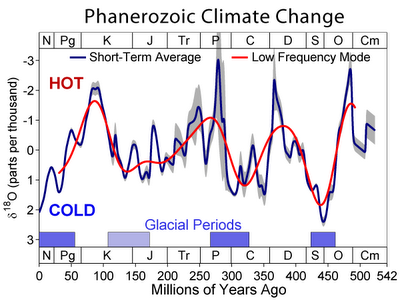Fossiles indicate global warming debate not over.
I consider myself a “global warming realist”. What that means is I really want to know what is happening, what are the options, etc.
Now one of my problems with the debate is that too much focus has gone into computer models which are only as good as the programs that are feed into them. And there are just too many holes in the theory.
One area I thought needed more exploration is what has happened with the climate in pre-industrial, even pre-human, history. This can be very enlightening to determine what is happening today. So I was pleased to see the New York Times run a fairly balanced article on the debate among paleoclimatologists and geologists.
The report notes that all of them basically agree that CO2 levels today are far lower than they were in the past. At times carbon dioxide levels in the atmosphere exceeded today’s levels by 18 times. Where the debate comes in is how much these levels impacted global temperatures. And knowing what has happened in the past is a good indicator of what will happen in the future.
My great skepticism about the warming alarmists is that they seem rather intent on ignoring the past, ingoring mitigating circumstances and dead set on using flawed computer models instead.
Geologist Robert Berner claims that the relationship between CO2 and temperature is rather strong. He admits, “There are other factors at work here. But in general, global warming is due to C02. It was in the past and is now.”
But other geologists are adamant that this is not the case. Robert Giegengack of the University of Pennsylvania says: “The record violates that one-to-one correspondence.” He says that there are many other substantial influences on global temperature such as sea currents, Sun cycles and cosmic rays.
Another expert, Jan Veizer of the University of Ottaw says: “More and more data point to the Sun and stars as the dominant driver.”
The Times reports that many of these scientists argue that the evidence from the past indicates a doubling of world carbon dioxide levels would impact global temperaturs by only 2 to 3 degrees. The paper also notes that this debate has been entirely ignored in public circles. “The Phanerozoic [the period covering life on the planet] dispute, fought mainly in scholarly journals and scientific meetings, has occurred in isolation fromt he public debate on global warming. Al Gore in An Inconvenient Truth makes no mention of it.”
Professor Giegengack says he is regular asked to stop mentioning the data. “People come to me and say, ‘Stop talking like this, you’re hurting the cause.’”
You can see one graph here showing the dramatic differences between CO2 levels in the past and today. And immediately below it is a chart showing global temperature change over the same period.


You will see that temperatures went through cycles. There were periods when the Earth was much warmer and other periods when it was much colder. But you will see that there were cold periods during times of intensely high C02 levels in the atmosphere. Note these images were produce by Robert Rohde of the Global Warming Art Project.
Prof. Berner, who we mentioned already “focused on computer models” to determine if there was a correlation. And he found them right from the start. But other scientists shunned the computer model and looked at fossile records.
A team from the University of New Mexico found that 440 million years ago carbon dioxice levels were 16 times higher than they are today. Yet the era in question was a period of global cooling. Dr. Veizer joined the debate by pointing to two periods when the Earth had ice ages but also had high carbon dioxide levels. And then Daniel Rothbam of the Massachusettes Insitute of Technology used marine rocks to determine past carbon dioxide levels and he said he found “no systematic correspondence” between C02 levels in the past and climate changes.
The Times then says that Dr. Veizer and Nir Shaviv, an astrophysicst at Hebrew University in Jerusalem developed a new model that “envisioned slow movements of the solar system through the surrounding galaxy as controlling the cosmic rays that bombarded Earth’s atmospher. A reduction they argued, would lessn cloud cover and Earth’s reflectivity, warming the planet. The reverse would cause colling. The Phanerozoic record of cosmic-ray bombardment showed excellent agreement with climate fluctuations trumping carbon dioxide, they wrote.”
For a discussion on the role of the Sun and cosmic rays on global warming, written for the general public, go here.
 DiggIt!
DiggIt! Reddit
Reddit Del.icio.us
Del.icio.us

<< Home